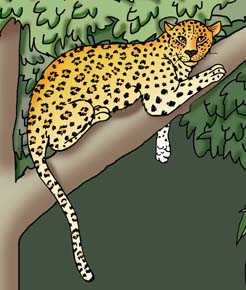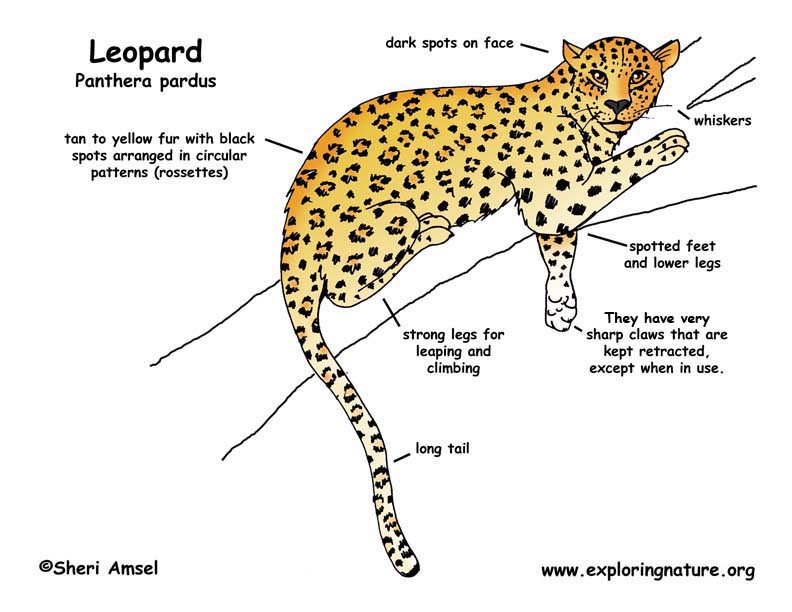

They are found in sub-Saharan Africa and in Asia.
They live in a variety of habitats from thick, scrubby riverbanks to rainforests and rocky, mountainous regions. They seem able to adapt more easily to new habitats than other big cats, which has helped them as human populations expand and they are pushed into different regions. They seem stable in their range compared to other large mammals.
They are large cats, though smaller than tigers, lions or jaguars. They can weigh up to 200 pounds (90 kgs) though usually weigh considerably less. They are tan to yellow with black markings. Though people think of leopards as having black spots, they actually only have spots on the face, feet and lower legs. The rest of their dark markings are spots forming circles (or rosettes). Some leopards are black, even among a family of yellow leopards, but underneath the black, the darker black spots are still there! This black leopard form is the result of melanism and is not a separate species.
Though they look somewhat like jaguars, if you compare them side by side you can see that jaguars have larger circles of spots and are larger cats in general with longer legs. The two species never cross paths in the wild, as jaguars are restricted to habitats in South and Central America.
They live alone (solitary) except when breeding and are active at night (nocturnal). They overlap habitats with other big predators in Africa and Asia, and have adapted by securing prey in trees away from more aggressive predators and surviving in varied habitats.
They eat meat (carnivores) and will eat any prey they can catch from fish to monkeys and including dead animals (carrion).
Their only predator is man.
Females are pregnant for about 10 weeks (gestation). They have 2-3 cubs, which are born gray and develop their color and spots over time.
They can live 20 years in captivity, but considerably less in the wild. They are listed as Lower Risk - least concern by CITES (Internationally) and endangered on the U.S. Federal Endangered Species List.
Kingdom: Animalia
Phylum: Chordata
Subphylum: Vertebrata
Class: Mammalia
Order: Carnivora
Suborder: Feliformia
Family: Felidae
Subfamily: Pantherinae
Genus: Panthera
Species: Panthera pardus
When you research information you must cite the reference. Citing for websites is different from citing from books, magazines and periodicals. The style of citing shown here is from the MLA Style Citations (Modern Language Association).
When citing a WEBSITE the general format is as follows.
Author Last Name, First Name(s). "Title: Subtitle of Part of Web Page, if appropriate." Title: Subtitle: Section of Page if appropriate. Sponsoring/Publishing Agency, If Given. Additional significant descriptive information. Date of Electronic Publication or other Date, such as Last Updated. Day Month Year of access < URL >.
Amsel, Sheri. "Leopard" Exploring Nature Educational Resource ©2005-2024. December 16, 2024
< http://www.exploringnature.org/db/view/476 >


